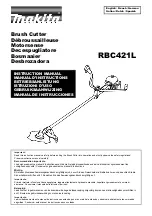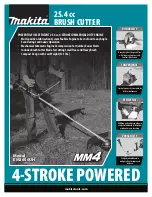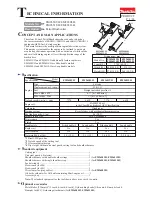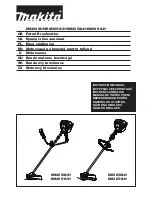
11
When in a confined area, prevent the
reflected arc rays from entering
around the helmet. Make sure others
are protected from arc rays and
sparks. Approved shielding curtains
and appropriate goggles should be
used to provide protection to others in
the surrounding area and operators of
nearby equipment.
Skin should also be protected from
arc rays, heat, sparks and molten
metal. Always wear protective gloves
and clothing, which will not allow skin
to become exposed. All pockets
should be closed and cuffs sewn
shut. Leather aprons, sleeves,
leggings, etc. should be worn for out-
of-position cutting. High top work
shoes provide adequate protection
from foot burns. For added protection
use leather spats. Flammable hair
preparations should not be used
when cutting. Wear earplugs to
protect ears from sparks.
SAFETY AND OPERATING
REFERENCES 1, 2, AND 3.
WELDING SPARKS
AND COMPRESSED
GASES CAN CAUSE
FIRES AND
EXPLOSIONS
Causes of fire and explosion are;
combustibles reached by the arc,
flame, flying sparks, hot slag or
heated materials. Remove
combustibles from the work area
and/or provide a fire watch. Avoid
oily or greasy clothing as a spark may
ignite them. Have a fire extinguisher
nearby, and know how to use it. Be
alert to the danger of conduction or
radiation, for example if cutting is to
be done on a metal wall, partition,
ceiling or roof, precautions must be
taken to prevent ignition of
combustibles on the other side. Do
not cut containers that have held
combustibles. All hollow spaces,
cavities and containers should be
vented prior to cutting to permit the
escape of air or gases. Purging with
inert gas is recommended.
Exothermic cutting operations use
oxygen, therefore all safety
precautions concerning the use of
oxygen must be observed. Oxygen
itself is not flammable, however, the
presence of pure oxygen will
drastically increase the speed and
force with which burning takes place.
Always refer to oxygen by its full
name "oxygen," and not by the word
"air." Never allow oil, grease or other
petroleum-based substances to come
in contact with cylinder valves,
regulators, hoses or any other part of
the oxygen supply system. Do not let
an arc, cutting rod or flame touch any
part of the oxygen supply system.
Chain or secure cylinders to an object
such as a cylinder cart, wall,
workbench, post, etc. When moving
cylinders, always be certain that valve
protection caps are securely in place.
Never stand in front or behind a
regulator when opening the cylinder
valve. Always stand so the cylinder is
between you and the regulator.
Never use compressed air instead of
oxygen. Keep oxygen cylinders away
from electrical connections
SEE SAFETY AND OPERATING
REFERENCES 1, 2, 5, AND 6.
SAFETY AND OPERATING
REFERENCES
1. Code of Federal Regulations,
(OSHA)
Section 29 Part 1910.95, 101,
132, 133, 134, 139, 251, 252,
253, 254, AND 1000.
U.S. Government Printing
Office
Washington, DC 20402
2. ANSI Z49.1 "Safety In Welding
And Cutting."
3. ANSI Z87.1 "Practice for
Occupational and Educational
Eye and Face Protection
4. ANSI Z88.2 "Standard Practice
for Respiratory Protection."
Содержание SLICE
Страница 1: ...1 Instruction Manual For SLICE Exothermic Cutting Equipment...
Страница 19: ......






































